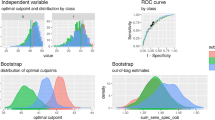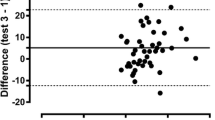Abstract
Objective
To assess the construct and criterion validity of the KIDSCREEN-27 health-related quality of life (HRQoL) questionnaire, a shorter version of the KIDSCREEN-52.
Methods
The five-dimensional KIDSCREEN-27 was tested in a sample of 22,827. For criterion validity the correlation with and the percentage explained variance of the scores of the KIDSCREEN-52 instrument were examined. Construct validity was assessed by testing a priori expected associations with other generic HRQoL measures (YQOL-S, PedsQL, CHIP), indicators of physical and mental health, and socioeconomic status. Age and gender differences were investigated.
Results
Correlation with corresponding scales of the KIDSCREEN-52 ranged from r = 0.63 to r = 0.96, and r 2 ranged from 0.39 to 0.92. Correlations between other HRQoL questionnaires and KIDSCREEN-27 dimensions were moderate to high for those assessing similar constructs (r = 0.36 to 0.63). Statistically significant and sizeable differences between physically and mentally healthy and ill children were found in all KIDSCREEN-27 dimensions together with strong associations with psychosomatic complaints (r = −0.52). Most of the KIDSCREEN-27 dimensions showed a gradient according to socio-economic status, age and gender.
Conclusions
The KIDSCREEN-27 seems to be a valid measure of HRQoL in children and adolescents. Further research is needed to assess longitudinal validity and sensitivity to change.
Similar content being viewed by others
Abbreviations
- CHIP-AE:
-
Child Health and Illness Profile-Adolescent Edition
- CSHCN:
-
Children with Special Health Care Needs Screener
- DIF:
-
Differential Item Functioning
- FAS:
-
Family Affluence Scale
- HBSC:
-
Health Behavior in School-aged Children
- HRQoL:
-
Health-Related Quality of life
- IRT:
-
Item Response Theory
- OLS:
-
Ordinal Logistic Regression
- PedsQoL:
-
Pediatric Quality of Life Inventory
- SDQ:
-
Strengths and Difficulties Questionnaire
- WHO:
-
World Health Organization
- YQOL-S:
-
Youth Quality of Life Instrument-Surveillance Version
References
Committee on Evaluation of Children’s Health NRC. Measuring Children’s Health (2004). Children’s health, the nation’s wealth: Assessing and improving child health (pp. 91–115). Washington, D.C.: The National Academies Press.
Felder-Puig, R., Frey, E., Proksch, K., Varni, J. W., Gadner, H., & Topf, R. (2004). Validation of the German version of the Pediatric Quality of Life Inventory (PedsQL) in childhood cancer patients off treatment and children with epilepsy. Quality Life Research, 13, 223–234.
Landgraf, J. M., Maunsell, E., Speechley, K.N., Bullinger, M., Campbell, S., Abetz, L., & Ware, J. E. (1998). Canadian-French, German and UK versions of the Child Health Questionnaire: Methodology and preliminary item scaling results. Quality Life Research, 7, 433–445.
Ravens-Sieberer, U., Erhart, M., Power, M., Auquier, P., Cloetta, B., Hagquist, C., Bruil, J., & Rajmil, L. (2003). Item-response-theory analyses of child and adolescent self-report quality of life data: The European cross-cultural research instrument KIDSCREEN. Quality Life Research, 12, 1793.
Ravens-Sieberer, U., Gosch, A., Rajmil, L., Erhart, M., Bruil, J., Duer, W., Auquier, P., Power, M., Abel, T., Czemy, L., Mazur, J., Czimbalmos, A., Tountas, Y., Hagquist, C., the European KIDSCREEN Group. (2005). The KIDSCREEN-52 Quality of life measure for children and adolescents: Development and first results from a European survey. Expert Review of Pharmacoeconomics & Outcomes Research, 5, 353–364.
Scientific Advisory Committee of the Medical Outcome Trust. (2002). Assessing health status and health-related quality of life instruments: attributes and review criteria. Quality Life Research, 11, 193–205.
Smith, G. T., McCarthy, D. M., & Anderson, K. G. (2000). On the sins of short-form development. Psychological Assessment, 12, 102–111.
Robitail, S., Ravens-Sieberer, U., Simeón, M. C., Rajmil, L., Buril, J., Power, M., Duer, W., Coleta, B., Czerny, L., Mazur, J., Czembalmos ,A., Tountas, Y., Hagquist, C., Kilroe, J., Auquier, P., & the KIDSCREEN group (in press). Testing the structural and cross-cultural validity of the KIDSCREEN-27 health-related quality of life questionnaire. Quality Life Research, doi: 10.1007/s11136-007-9241-1
Berra, Ravens-Sieberer, U., Erhart, M., Tebé, C., Bisegger, C., Duer, W., von Rueden, U., Herdman, M., Alonso, J., Rajmil, L., & the KIDSCREEN group (in press). Methods and representativeness of European surveys on children and adolescents: the KIDSCREEN study. BMC Public Health
Varni, J. W., Seid, M., & Kurtin, P. S. (2001). PedsQL 4.0: reliability and validity of the Pediatric Quality of Life Inventory version 4.0 generic core scales in healthy and patient populations. Medical Care, 39, 800–812.
Starfield, B., Riley, A., Green, B., Ensminger, M., Ryan, S., & Kelleher, H. (1995). The adolescent CHIP: a population-based measure of health. Medical Care 33, 553–566.
Edwards, T. C., Huebner, C. E., Connell, F. A., & Partick, D. L. (2002). Adolescent Quality of Life, Part I: Conceptual and measurement model. Journal of Adolescent Health, 25, 275–286.
Patrick, D. L., Edwards, T. C., & Topolski, T. D. (2002). Adolescent Quality of Life, Part II: Initial Validation of a New Instrument. Journal of Adolescent Health, 25, 287–300.
Boyce, W., Torsheim, T., Currie, C., & Zambon, A. (2006). The Family Affluence Scale as a measure of national wealth: Validation of an adolescent self-report measure. Social Indicators Research, 78, 473–487.
Bethell, C. D., Read, D., Stein, R. E., Blumberg, S. J., Wells, N., & Newacheck, P. W. (2002). Identifying children with special health care needs: Development and evaluation of a short screening instrument. Ambulatory Pediatrics, 2, 38–48.
Bethell, C. D., Read, D., Neff, J., Blumberg, S. J., Stein, R. E., Sharp, V., & Newacheck, P. W. (2002). Comparison of the children with special health care needs screener to the questionnaire for identifying children with chronic conditions-revised. Ambulatory Pediatrics, 2, 49–57.
Eiser, C., & Morse, R (2001). A review of measures of quality of life for children with chronic illness. Archives of Disease in Childhood, 84, 205–211.
Goodman, R. (1997). The Strengths and Difficulties Questionnaire: a research note. Journal of Child Psychology and Psychiatry, 38, 581–586.
Information for researchers and professionals about the Strengths & Difficulties Questionnaires. Scoring of the SDQ. Retrieved May 15, 2007, from http://sdqinfo.com/b4html.
Currie, C. E., Elton, R. A., Todd, J., & Platt, S. (1997). Indicators of socioeconomic status for adolescents: the WHO Health Behaviour in School-aged Children Survey. Health Education Research, 12, 385–397.
Bortz, J., & Döring, N. (2002). Forschungsmethoden und Evaluation (3rd ed.). Berlin: Springer.
Cohen, J. (1988). Statistical power analysis for the behavioral sciences (2nd ed.). Hillsdale: Lawrence Erlbaum.
Nunnally, J., & Bernstein, I. J. (1994). Psychometric theory (3rd ed.). New York: Mc-Graw-Hill.
Starfield, B., Riley, A. W., Witt, W. P., & Robertson, J. (2002). Social class gradients in health during adolescence. Journal of Epidemiology and Community Health, 56, 354–361.
Vingilis, E. R., Wade, T., & Seeley, J. S. (2002). Predictors of adolescent self-rated health. Analysis of the National Population Health Survey. Canadian Journal of Public Health, 93, 193–197.
Cavallo, F., Zambon, A., Borraccino, A., Ravens-Sieberer, U., Torsheim, T., Lemma, P., the Positive HBSC Health Group (2006). Girls growing through adolescence have a higher risk of poor health. Quality Life Research, 15, 1577–1585.
Bisegger, C., Cloetta, B., von Rueden, U., Abet, T., Ravens-Sieberer, U., the European KIDSCREEN group (2005). Health-related quality of life: gender differences in childhood and adolescence. Social and Preventive Medicine, 50, 281–291.
Acknowledgement
The KIDSCREEN project was financed by a grant from the European Commission (QLG-CT-2000-00751) within the EC 5th Framework-Programme “Quality of Life and Management of Living Resources”.
Author information
Authors and Affiliations
Consortia
Corresponding author
Additional information
Members of the KIDSCREEN group are: Austria: Wolfgang Duer, Kristina Fuerth; Czech Republic: Ladislav Czerny; France: Pascal Auquier, Marie-Claude Simeoni, Stephane Robitail, Germany: Ulrike Ravens-Sieberer (international coordinator in chief), Michael Erhart, Jennifer Nickel, Bärbel-Maria Kurth, Angela Gosch, Ursula von Rüden; Greece: Yannis Tountas, Christina Dimitrakakis; Hungary: Agnes Czimbalmos, Anna Aszman; Ireland: Jean Kilroe, Eimear Flannery; The Netherlands: Jeanet Bruil, Symone Detmar, Eric Veripps; Poland: Joanna Mazur, Ewa Mierzejeswka; Spain: Luis Rajmil, Silvina Berra, Cristian Tebé, Michael Herdman, Jordi Alonso; Sweden: Curt Hagquist; Switzerland: Thomas Abel, Corinna Bisegger, Bernhard Cloetta, Claudia Farley; United Kingdom: Mick Power, Clare Atherton, Katy Phillips
Rights and permissions
About this article
Cite this article
Ravens-Sieberer, U., Auquier, P., Erhart, M. et al. The KIDSCREEN-27 quality of life measure for children and adolescents: psychometric results from a cross-cultural survey in 13 European countries. Qual Life Res 16, 1347–1356 (2007). https://doi.org/10.1007/s11136-007-9240-2
Received:
Accepted:
Published:
Issue Date:
DOI: https://doi.org/10.1007/s11136-007-9240-2




